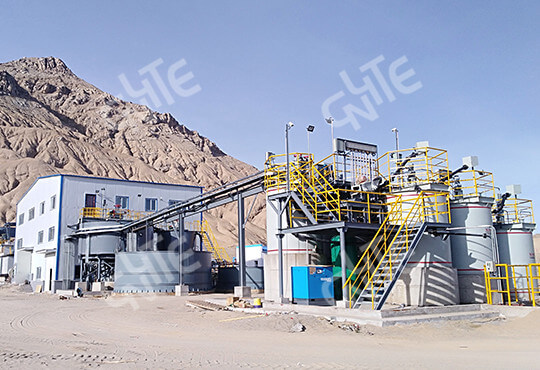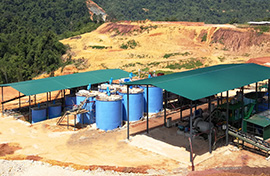-
 E-mail
xhcnlite@ytxinhai.com
E-mail
xhcnlite@ytxinhai.com
-
 Call Us
008617307193314
Call Us
008617307193314
 E-mail
xhcnlite@ytxinhai.com
E-mail
xhcnlite@ytxinhai.com
 Call Us
008617307193314
Call Us
008617307193314
2019-12-27 Views: 6200
Warm Tip: If you want to know more information, like quotation, products, solutions, etc., please Click here ,and contact us online.

Gold Cyanidation is a method in which gold is extracted from gold-bearing ores using aqueous solution of cyanide as solvent, and then gold is extracted from gold-bearing leaching solution. It includes cyanide leaching process and deposition gold extraction process. First, gold in the gold-bearing ore reacts with cyanide to form a complex into the solution, and then the gold is removed from the solution to metal by a displacement reaction using reactive metal such as zinc. The reaction equation is: 4Au+8NaCN+2H2O+O2=4Na [Au (CN) 2] +4NaOH 2 Na [Au (CN) 2] +Zn=2Au+Na2 [Zn (CN) 4]
The specific steps of gold cyanidation mainly include: ore's preparation stage, leaching stage and metal recovery stage.
The preparation stage of ore is an essential process for gold extraction, which is mainly by crushing and grinding the ore to reduce the particle size of the ore. It can ensured that gold is present in the cyanide aqueous solution in the most economical form of recovery, thereby increasing the gold recovery rate. In addition to the crushing and grinding process, gold ore containing sulphide or carbonaceous minerals requires additional treatment prior to recycling. This is because cyanide leaches out sulfide firstly rather than metal, which will cause the consumption of cyanide. To counteract this effect, these ores can first through the flotation process to limit the interaction with cyanide during the leaching process. In addition, it is also possible to change the leaching process by adding activated carbon to preferentially adsorb gold.
The concentration of cyanide used in the leaching process ranges from 300 to 500 mg / l (0.03 to 0.05% in terms of NaCN), mainly depending on the mineralogy of the ore. In the leaching process, the grinded ore is first conveyed to a series of leaching tanks, and the slurry is stirred by mechanical force or by injecting air to increase the contact between cyanide and gold and improve the leaching efficiency. The cyanide then dissolves the gold from the ore to form a stable metal-cyanide complex. At the beginning of the leaching, the pH of the slurry is raised to pH 10-11 using lime to ensure that it can’t produce toxic hydrogen cyanide gas when cyanide is added. Activated carbon is used in the dissolved gold extraction process, either by introducing it directly into the CIL (carbon-in-leach) tanks or into separate CIP (carbon-in-pulp) tanks after leaching. The activated carbon adsorbs the dissolved metal from the leach slurry thereby concentrating it onto solids. The carbon is then separated from the slurry by screening and subjected to further treatment to recover the adsorbed metal.
Gold are extracted from the solution first using either cementation on zinc powder or concentrating the metal using adsorption on activated carbon, followed by elution and concluding with either cementation with zinc or electrowinning. The most cost-effective method is to make the dissolved gold adsorb to the activated carbon, making it easy to achieve the separation of the solid-solid. To achieve this, the ore particles must generally be smaller than 100 μm and the carbon particles must be larger than 500 μm. These steps can be done after CIL or CIP process. Activated carbon in contact with a pulp containing gold and/or silver can typically recover more than 99.5% of the metals in the solution in 8 to 24 hours, depending on the reactivity of the carbon, the amount of carbon used and the mixer's efficiency. The gold adsorbed on the activated carbon is recovered from the carbon by electrolysis, and then the carbon is returned to the adsorption loop for further use. The gold obtained will be refined by calcination into gold bars containing 70-90% gold. The bullion is then further refined to either 99.99% or 99.999% fineness using chlorination, smelting and electro-refining.
The recovery rate of gold cyanidation is very high. And gold can be produced on the spot, which can avoid the various drawbacks of long-distance transportation of gold concentrate, thus conducive to improving the economic benefits of enterprises.
• The gold extraction process flow lasts long, and the extraction speed is slow. • As a highly toxic material, cyanide poses a serious threat to the ecological environment and animal life. Therefore, the slurry waste discharge should be strictly controlled when cyanide is used for gold extraction. In order to avoid the environmental damage caused by cyanide, many mine owners begin to use new non-toxic or low toxic leaching agents for gold extraction, which can not only replace sodium cyanide without changing the original equipment and cyanidation process, but also can achieve 100% environmental protection.
There is a 270tpd gold and silver cyanidation plant in Japan, in which the metal minerals mainly include native gold, silver, and pyrite. Gangue minerals mainly composed of quartz and calcite. Gold exists mainly in free state in ore. The ore contains 5.0g/t of gold and 20g/t of silver. The plant completely adopts the all sliming cyanidation method, the final gold recovery rate is 97.6%, and the silver recovery rate is 89%. The tailings contain 0.12 g/t of gold and 2.4 g/t of silver.
No. 188, Xinhai Street, high-tech Industrial Park, Fushan District, Yantai, Shandong, China.

Please leave your message here! We will send detail technical info and quotation to you!